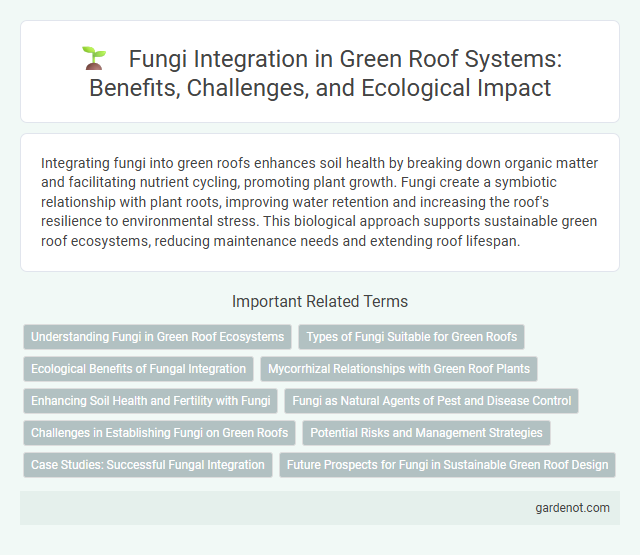Integrating fungi into green roofs enhances soil health by breaking down organic matter and facilitating nutrient cycling, promoting plant growth. Fungi create a symbiotic relationship with plant roots, improving water retention and increasing the roof's resilience to environmental stress. This biological approach supports sustainable green roof ecosystems, reducing maintenance needs and extending roof lifespan.
Understanding Fungi in Green Roof Ecosystems
Fungi play a crucial role in green roof ecosystems by enhancing nutrient cycling and improving soil structure through mycorrhizal associations with plant roots. These symbiotic relationships increase water retention and promote plant health by facilitating the uptake of phosphorus and nitrogen. Integrating fungi in green roofs supports biodiversity and resilience, making the rooftop environment more sustainable and productive.
Types of Fungi Suitable for Green Roofs
Certain fungi, such as mycorrhizal fungi and saprophytic fungi, are highly suitable for integration into green roofs due to their ability to enhance nutrient cycling and improve soil structure. Mycorrhizal fungi form symbiotic relationships with plant roots, increasing water and nutrient uptake while promoting plant health and resilience. Saprophytic fungi contribute to organic matter decomposition, supporting sustainable substrate ecosystems that enhance the overall functionality and longevity of green roof systems.
Ecological Benefits of Fungal Integration
Fungal integration in green roofs enhances soil health by promoting nutrient cycling and organic matter decomposition, improving plant growth and resilience. Mycorrhizal fungi establish symbiotic relationships with plant roots, increasing water retention and drought resistance. This microbial activity supports biodiversity, reduces urban heat island effects, and mitigates stormwater runoff.
Mycorrhizal Relationships with Green Roof Plants
Fungi integration in green roofs enhances plant health by establishing mycorrhizal relationships that improve nutrient and water uptake. These symbiotic associations increase plant resilience to environmental stress and promote sustainable growth in urban rooftop ecosystems. Mycorrhizal fungi also facilitate soil microbial diversity, contributing to long-term green roof vitality and ecological balance.
Enhancing Soil Health and Fertility with Fungi
Integrating fungi into green roof systems significantly enhances soil health and fertility by promoting nutrient cycling and organic matter decomposition, which boosts plant growth and resilience. Mycorrhizal fungi establish symbiotic relationships with plant roots, increasing nutrient and water absorption efficiency in shallow substrates typical of green roofs. This biological augmentation supports sustainable urban ecosystems by improving soil structure, moisture retention, and overall biodiversity.
Fungi as Natural Agents of Pest and Disease Control
Fungi integrated into green roofs act as natural biocontrol agents by suppressing harmful pests and diseases, promoting plant health without synthetic chemicals. Beneficial fungi such as mycorrhizae enhance nutrient uptake and soil structure, while antagonistic fungi inhibit pathogenic organisms. This ecological synergy reduces reliance on pesticides, fostering sustainable urban ecosystems through a balanced microbial environment.
Challenges in Establishing Fungi on Green Roofs
Establishing fungi on green roofs faces challenges such as maintaining optimal moisture and temperature levels critical for fungal colonization and growth. Limited substrate depth and variability in organic matter content restrict fungal nutrient sources, impacting mycorrhizal network development. Furthermore, exposure to urban pollutants and fluctuating environmental conditions can inhibit fungal spore viability and ecosystem stability on green roof substrates.
Potential Risks and Management Strategies
Fungi integration in green roofs presents potential risks such as structural damage from aggressive mycelium growth and the proliferation of harmful molds that can affect plant health and air quality. Effective management strategies include regular monitoring of fungal species, using mycelium-compatible substrates, and applying biological controls to limit pathogenic fungi. Proper drainage systems and maintaining optimal moisture levels also help prevent fungal overgrowth and preserve the integrity of the green roof ecosystem.
Case Studies: Successful Fungal Integration
Case studies of fungal integration in green roofs reveal significant improvements in soil health and plant resilience through mycelium networks that enhance nutrient cycling and water retention. Research from the University of Sheffield demonstrates a 30% increase in rooftop vegetation survival rates when fungal inoculants were applied. Urban installations in Berlin and Toronto highlight reduced thermal stress and improved ecosystem biodiversity linked to fungal symbiosis in green roof substrates.
Future Prospects for Fungi in Sustainable Green Roof Design
Fungi integration in sustainable green roof design presents promising future prospects by enhancing nutrient cycling and improving plant health through mycorrhizal networks. These symbiotic relationships increase soil structure stability and water retention, reducing irrigation needs while promoting resilience against environmental stressors. Advances in fungal biotechnology may enable tailored fungal species selection, optimizing ecosystem services and contributing to carbon sequestration on urban rooftops.
Fungi integration roof Infographic

 gardenot.com
gardenot.com